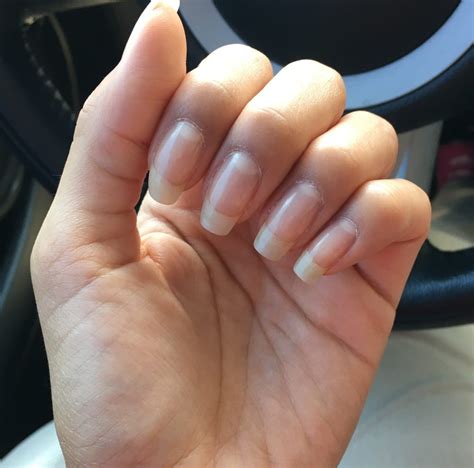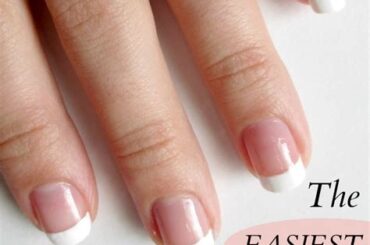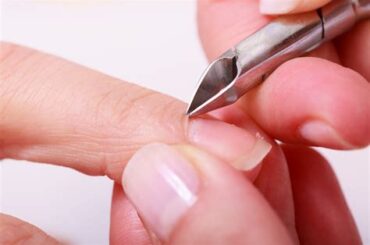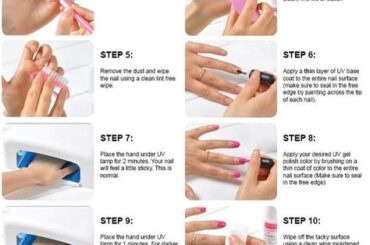Are you tired of dealing with brittle, weak nails that always seem to break at the most inconvenient times? Understanding the science behind nail care is essential to achieving and maintaining strong, healthy nails. In this blog post, we will explore the various aspects of nail care, from the structure of nails to the role of proper hygiene and the impact of diet on their health. We will also discuss the importance of choosing the right nail products, effective home remedies for strengthening nails, and common nail problems and their solutions. Additionally, we will provide tips for caring for different nail types and safely removing nail polish, as well as what to expect during professional nail care at a salon. By the end of this post, you will have the knowledge and tools to achieve the beautiful, strong nails you’ve always wanted. So, let’s dive into the science of nail care and uncover the tips for healthy and strong nails!
Understanding the Structure of Nails
Have you ever wondered what the actual structure of your nails is? Nails are composed of a protein called keratin, which is also found in our hair and skin. They are made up of several parts, including the nail plate, nail bed, cuticle, nail matrix, and lunula. The nail plate is the visible part of the nail, while the nail bed is the skin underneath the nail. The cuticle is the thin layer of skin that covers the base of the nail, and the nail matrix is responsible for producing the cells that become the nail plate. The lunula, commonly referred to as the half moon, is the visible part of the nail matrix. Understanding the anatomy of nails can help in maintaining their health and appearance.
It’s important to take care of the entire structure of the nails to ensure their strength and overall health. The nail plate, for example, can become brittle if not properly moisturized, while the cuticle serves as a protective barrier against bacteria and fungi. The nail bed is also susceptible to infections, so it’s crucial to keep it clean and dry. By understanding the different components of the nails, individuals can approach nail care in a more holistic manner, targeting specific areas for maintenance and improvement.
Moreover, being aware of the structure of nails can also help in identifying potential problems. Changes in the appearance or texture of the nails could be indicative of underlying health issues, and understanding their anatomy can assist in recognizing these warning signs. Whether it’s discoloration, ridges, or growth abnormalities, being knowledgeable about the structure of nails can prompt individuals to seek medical attention if necessary, preventing further complications.
In conclusion, understanding the structure of nails is crucial for maintaining their health and appearance. By knowing the different components and their functions, individuals can effectively care for their nails and identify potential problems. Whether it’s protecting the nail bed, moisturizing the nail plate, or maintaining the cuticle, a comprehensive understanding of nail structure can lead to stronger, healthier nails.
Importance of Proper Nail Hygiene
Proper nail hygiene is essential for maintaining healthy and strong nails. Neglecting the health of your nails can lead to various problems such as infections, brittleness, and discoloration. Nail hygiene goes beyond just having neat and tidy nails; it involves regular cleaning, moisturizing, and protecting your nails from damage.
One of the most important reasons to maintain proper nail hygiene is to prevent the spread of infections. Bacteria and fungus can thrive in dirty and moist environments, making your nails susceptible to infections. By keeping your nails clean and dry, you can significantly reduce the risk of developing nail infections.
In addition to preventing infections, proper nail hygiene also promotes overall nail health. Regular moisturizing and trimming can help prevent dry and brittle nails, while protecting your nails from harsh chemicals and excessive use of nail products can help maintain their strength and natural shine.
Furthermore, maintaining proper nail hygiene can also contribute to your overall appearance and self-confidence. Neat and well-groomed nails can leave a positive impression on others and boost your self-esteem. By incorporating simple nail care routines into your daily grooming habits, you can improve the overall health and appearance of your nails.
Nail Care for Stronger and Healthier Nails
Proper nail care is essential for maintaining strong and healthy nails. There are several tips and tricks that can help you achieve the nails you’ve always wanted. Firstly, it’s important to keep your nails clean and dry to prevent them from becoming brittle and weak. This can be achieved by using a gentle soap and water to clean your nails and making sure to thoroughly dry them afterwards.
Another important aspect of nail care is to regularly trim and file your nails to prevent them from breaking and becoming damaged. This not only helps to keep your nails looking neat and tidy, but it also protects them from becoming weak and brittle. Remember to always trim your nails straight across and then round the tips in a gentle curve to prevent ingrown nails.
In addition to trimming and filing, maintaining a healthy and balanced diet is also crucial for nail health. Consuming nutrient-rich foods that are high in protein, vitamins and minerals can help to promote strong and healthy nails. Foods such as eggs, fish, nuts, and leafy greens are particularly beneficial for nail growth and strength.
Lastly, using a moisturizing nail cream or oil can help to keep your nails hydrated and prevent them from becoming dry and brittle. It’s important to apply the cream or oil to your nails and cuticles regularly in order to maintain their strength and flexibility. By following these nail care tips, you can achieve stronger and healthier nails in no time.
Choosing the Right Nail Products
When it comes to nail care, choosing the right nail products is essential for maintaining healthy and strong nails. With so many options available in the market, it can be overwhelming to select the best products for your specific nail type. However, taking the time to educate yourself about the different types of nail products and their components can make all the difference in achieving the desired results.
One of the most important factors to consider when choosing nail products is the ingredients. Opt for products that are free from harsh chemicals such as formaldehyde, toluene, and DBP, as these can cause damage to the nails and surrounding skin. Look for nail polishes, nail strengtheners, and cuticle oils that are formulated with nourishing ingredients like vitamin E, keratin, and natural oils to promote overall nail health.
Another crucial aspect to keep in mind is your specific nail concerns. If you have brittle nails, prioritize strengthening formulas that provide added support and protection. For those with dry and damaged cuticles, investing in a moisturizing cuticle oil can help to improve their overall condition. Understanding your individual nail needs will help you make informed decisions when shopping for nail products.
Lastly, don’t forget to consider the brand reputation and customer reviews before making a purchase. Look for trusted brands known for their quality nail products and read user feedback to gain insights into their effectiveness. Additionally, seek recommendations from nail care professionals or friends who have had positive experiences with certain products.
Effective Home Remedies for Nail Strengthening
Proper nail care is essential for achieving strong and healthy nails. While there are a plethora of nail products in the market promising to strengthen your nails, there are also effective home remedies that can help in achieving the same result. One of the most popular home remedies is using olive oil to strengthen and moisturize the nails. Massaging warm olive oil onto the nails and cuticles can help improve their strength and flexibility.
Another effective home remedy for nail strengthening is lemon juice. Lemon juice is a natural bleaching agent that can help in removing stains from the nails. It also contains vitamin C, which is essential for promoting nail growth and strength. Simply dipping your nails in a mixture of lemon juice and warm water for a few minutes can do wonders for strengthening your nails.
In addition to olive oil and lemon juice, coconut oil is also known for its nail-strengthening properties. Coconut oil contains fatty acids that can penetrate the nail and prevent it from becoming brittle. Applying coconut oil to the nails and cuticles on a regular basis can help in maintaining their strength and preventing breakage.
Garlic is another powerful home remedy for nail strengthening. It contains selenium, which is known for promoting nail growth. You can crush a few garlic cloves and mix it with a base oil like olive oil or coconut oil. Applying this mixture to your nails can help in making them stronger and healthier.
The Role of Diet in Nail Health
When it comes to nail health, many people tend to focus solely on external care such as manicures and nail treatments. However, the role of diet in maintaining healthy nails should not be overlooked. Proper nutrition plays a crucial role in ensuring that your nails are strong, resilient, and free from common problems such as brittleness and breakage.
One of the key nutrients that contribute to nail health is protein. Protein is essential for the growth and repair of tissues, including the nails. Including sources of lean protein such as poultry, fish, and legumes in your diet can help promote healthy nail growth and strength.
In addition to protein, omega-3 fatty acids are also vital for nail health. These healthy fats are known for their anti-inflammatory properties, which can help prevent common nail issues such as dryness and brittleness. Incorporating foods rich in omega-3s, such as salmon, chia seeds, and walnuts, into your diet can benefit both your nails and overall health.
Furthermore, essential vitamins and minerals such as biotin, vitamin E, and iron play a crucial role in maintaining nail health. Biotin, also known as vitamin B7, is often touted for its ability to improve the strength and thickness of nails. Foods such as eggs, almonds, and sweet potatoes are excellent sources of biotin and can be included in a nail-friendly diet.
Common Nail Problems and Their Solutions
One of the most common nail problems that people face is nail fungus, which can cause nails to become discolored, thickened, and brittle. This can be treated with over-the-counter antifungal medications, or in severe cases, prescription medications prescribed by a doctor. It’s important to practice good nail hygiene and keep nails clean and dry to prevent nail fungus from occurring.
Another common issue is dry, brittle nails, which can be caused by frequent hand washing, using harsh chemicals, or simply aging. To combat this problem, it’s important to regularly moisturize the nails with a nourishing oil, such as jojoba or coconut oil. Additionally, wearing gloves when doing chores or using harsh chemicals can help protect the nails from damage.
Ingrown nails can also be a painful and common problem. This occurs when the edge of the nail grows into the surrounding skin, leading to redness, swelling, and pain. Soaking the affected nail in warm water, gently lifting the edge of the nail, and keeping the area clean can help alleviate the discomfort. In severe cases, a doctor may need to perform a minor surgical procedure to remove the ingrown portion of the nail.
Lastly, nail ridges, which are vertical or horizontal lines on the nails, can be a cosmetic concern for many people. These ridges can be caused by aging, nutrient deficiencies, or underlying health conditions. Maintaining a healthy diet rich in vitamins and minerals, along with using a ridge-filling nail polish, can help minimize the appearance of nail ridges.
Nail Care Tips for Different Nail Types
When it comes to nail care, not all nails are created equal. Different nail types require different approaches to ensure they remain strong and healthy. Whether you have brittle nails, soft nails, or normal nails, understanding the specific needs of your nails is essential in maintaining their overall health.
For brittle nails, it’s important to focus on hydration and protection. Using a moisturizing nail and cuticle oil can help restore flexibility and prevent breakage. Avoiding harsh chemicals and using a strengthening base coat can also provide an extra layer of protection.
On the other hand, soft nails require a different approach. Gentle filing and regular maintenance are key to preventing tears and peeling. A calcium-rich nail hardener can also help improve the strength and structure of soft nails.
For those with normal nails, maintaining a balanced nail care routine is essential. Regular trimming, moisturizing, and using a protective top coat can help keep normal nails healthy and strong. Avoiding excessive exposure to water and harsh chemicals can also prevent weakening of the nails.
How to Safely Remove Nail Polish
When it comes to removing nail polish, it’s important to do it in a way that doesn’t damage your nails. Here are some tips for safely removing nail polish:
First, you should always use acetone-free nail polish remover to prevent drying out your nails. Acetone can be harsh and damaging, especially if you have weak or brittle nails. Look for a nail polish remover that is gentle and nourishing.
Next, be sure to moisturize your nails after removing nail polish. Nail polish remover can strip your nails of their natural oils, so it’s important to replenish this moisture. Use a nourishing cuticle oil or moisturizing nail cream to keep your nails healthy and hydrated.
Lastly, try to avoid scraping or picking at your nails when removing nail polish. This can cause damage and weaken the nails. Use a gentle touch and be patient when removing nail polish, and always follow up with a strengthening base coat to protect your nails.
Professional Nail Care: What to Expect at a Salon
When you walk into a salon for professional nail care, you can expect a relaxing and pampering experience. The first step is usually to consult with the nail technician about your preferences and any specific issues you may have with your nails. This could include discussing the shape and length you want for your nails, as well as any concerns about the health of your nails or cuticles.
Once your preferences have been established, the nail technician will start by shaping your nails using professional tools. This will be followed by a gentle cuticle treatment to ensure the health and appearance of your nail beds. If you opt for a manicure, you can expect a luxurious hand massage and the application of high-quality nail polish in the color of your choice. For those getting a pedicure, a similar process will be followed for the nails on your feet.
Professional nail care also often includes additional treatments such as exfoliation, moisturizing masks, and heat therapy to further pamper and nourish your nails and skin. Some salons may also offer specialty treatments like nail strengthening or nail art, so be sure to inquire about any extra services that interest you.
Overall, professional nail care at a salon promises a dedicated focus on the health and beauty of your nails, as well as a relaxing experience in a tranquil environment. By choosing a reputable salon, you can expect top-notch service and the use of high-quality products to ensure that your nails receive the best care possible.





